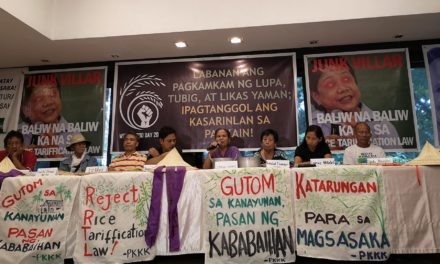Overwhelmed is the word I’d use to describe how I felt during that moment.
I expected only 15 to 20 women for the focus group discussion (FGD) at Isla de Gigantes as part of Focus on the Global South’s (FGS) exploratory research on and assessment of Super Typhoon Yolanda-affected areas. But more than a hundred women turned up, surrounding me in the small house made of bamboo – with no ceilings and walls and only a blue plastic tarpaulin for a roof.
A Coleman tent donated by foreign tourists served as their temporary shelter. I would be told later by my local hosts that the women thought I was bringing relief goods or at least, they had expected I could help alleviate their condition.
These women – wives, mothers, and children of fishermen – belong to the Asosayon sa Magagmay nga Mangingisda sa Lantangan or the Association of Artisinal Fishefolks in Lantangan (AMMALAN). They told me stories of how they survived, of how they still feared for their future, and of how they wanted to hope and dream again.
Devastated
They had barely recovered from the impacts of Typhoon Frank (Fengshen) that hit in 2008 when Yolanda (Haiyan) wrought devastation to the almost 10,000 people of Lantangan village located in Isla de Gigantes.
The majority of the residents rely on fishing in the Visayan sea. Isla de Gigantes is a group of islands 25 kilometers off the cost of Estancia and Carles in Northern Iloilo. Rarely visited due to inaccessibility and the roughness of waves, a shroud of mysticism and concealment looms over the island characterized by its steep limestone cliffs.
Being far from the mainland of Panay has made it one of the most vulnerable and poorest barangays of Iloilo. Unofficial estimates stated that more than 90% of the houses in the island were damaged. Almost all fishing boats were destroyed. Even the biggest boat was washed away, now lying on its side and badly needing repair.
Relief missions have been provided by the Bureau of Fisheries and Aquatic Resources in Region 6 (BFAR-6), Loma Linda University Health (LLUH), the Adventist Development and Relief Agency (ADRA), Christian Aid, SM, Iglesia ni Cristo, GMA- Kapuso Foundation, PLDT, Department of Social Welfare and Development (DSWD), British and Canadian aid, and private individuals and relatives.
The relief efforts to the community seem to be numerous but still, not everyone received their fair share of goods that came in the form of rice, bottled water, canned goods, clothes, and tarpaulins for the destroyed houses.
Out of the 1,252 families, only an estimated 500 goods were received.
According to Brgy. Lantangan women, the consequences of Yolanda are the most obvious and immediate – loss of life, property and infrastructure. “Naguba na ang balay, naguba pa ang bangka.” (Not only our houses but also our boats were destroyed.)
AMMALAN member Jesus Tundag said a steady source of income is difficult to find after Yolanda. Not only were their boats destroyed, they also had to compete with commercial fishers.
Another fisherman from Sitio Dapdap projects that in a year’s time, the Visayan Sea will face a crisis due to overfishing and overexploitation. Thousands of corals are also destroyed, leaving nowhere for the fish to lay their eggs and re-populate.
The women
Security of income and livelihood is a pressing concern for the community.
“Di kami makabangon dahil walang pampagawa ng bangka… Wala ring ibang mapagkukunan ng pagkakakitaan. Bago mag-Yolanda, nakakaraos kami. Tinutulungan namin ang aming asawa sa pagtitinda ng isda. Pero ngayon na problema ang bangka at dalawang buwan ng mahirap mangisda dahil sa sama ng panahon, taghirap at taggutom na kami.”, said Marlyn Varilla, one of the women who attended the FGD.
(It’s hard to recover because we don’t have resources to rebuild our boats. We don’t have other sources of livelihood. Before Yolanda, we were getting by because we help our husbands sell the fish they catch. Now that we’ve lost our boats and we can’t fish due to the roughness of the sea, we are experiencing hunger.)
Other women chimed in, saying that while they welcome relief goods, what they need is something more sustainable – jobs and livelihood.
To get through the crisis, the wives and mothers had to find odd jobs such as paglalabada (washing laundry) and paglalako (hawking). If they couldn’t find any other job, they resort to informal lending. If worse comes to worse, they skip one or two meals in a day.
These women’s perseverance show their resourcefulness and craftiness – diskarte – in the hope that better days will come soon.
But the women very well understand that the more long-term and difficult outcomes of such disaster are increased vulnerabilities – loss of livelihoods, malnutrition, poverty and hunger – which can further lead to emigration and trafficking that exacerbate social disparities and spur social conflicts.
If their needs are not addressed, diskarte could very well become a practical way of life for the improverished community. The crisis brought by Yolanda could become a chronic situation.
Rebuilding, living
For the community, to bounce back means being given a holistic solution that not only reduces community vulnerability but also paves the way for long-term rehabilitation – one that prioritizes affected peoples’ needs and aspirations is needed.
This might be an impossible task but it offers an opportunity for the community to begin a process of healing, recovery and rebuilding. The point here is for the affected people to be part of the process of rebuilding, not only as victims but also as people who can become agents of change, who can rise above their situation.
People could get back on their feet after the typhoon. My visit in the island showed some semblance of normalcy – children going to school albeit on shorter periods, boats being repaired, children playing on the beach.
But for them to finally recover, strategic and sustained interventions coming from the local and national governments are needed, especially at this critical period. In the mind of Norife Tundag, wife of Jesus Tundag, rehabilitation and recovery means having a simple life – being able to put food and water on the table three times a day, having a good and secure shelter, good health, being able to send their children to school and earning a decent living for both men and women.
Norife was talking about a bundle of interconnected rights being guaranteed and protected. She spoke about freedoms, too. Freedom from want, poverty and hunger. Independence from relief.
Enabling her and her community to have simple lives means giving back power – power to enjoy their rights, freedoms, uplift them from multiple burdens, helplessness and vulnerabilities. Self-recovery and rebuilding can only happen if these vulnerable communities are given an enabling environment to stand on their own feet.
This article was published by Rappler on March 8, 2014.









